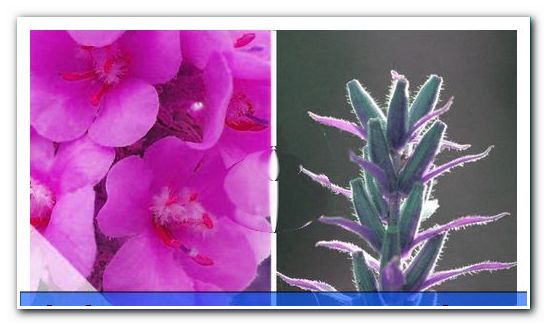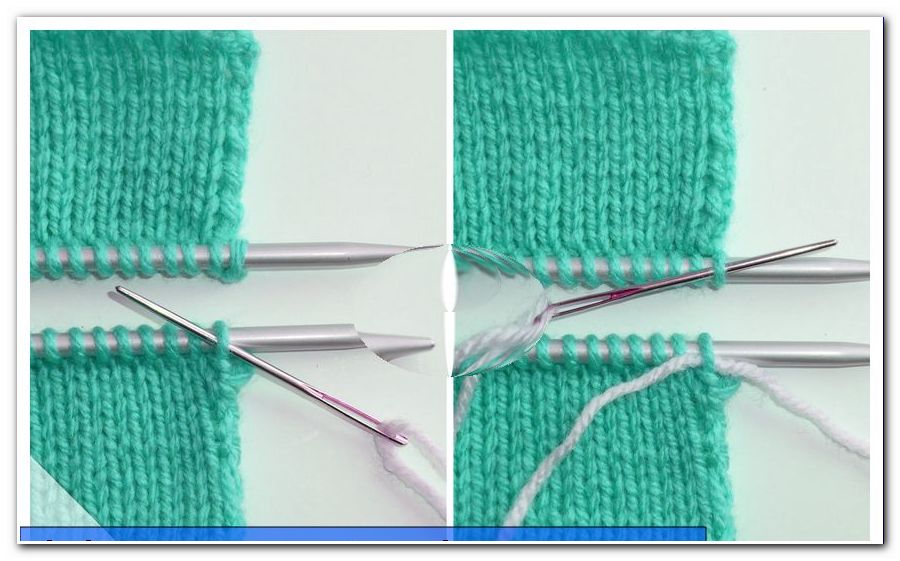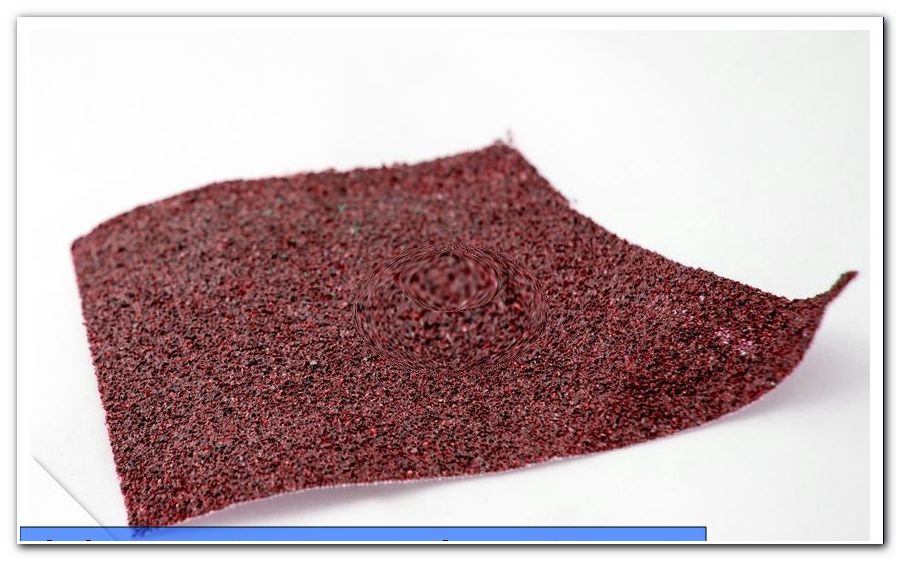Mullein - care in the garden

- Short profile
- Verbascum - species and varieties
- The care of the mullein
- Location
- plant substrate
- plants
- Pouring and fertilizing
- To cut
- overwinter
- multiply
- sowing
- Diseases and pests
- Frequently asked questions
The Mullein is an impressive perennial plant. There are many types and varieties, some up to 250 cm high. The magnificent inflorescences in bright or pastel colors are a real eye-catcher in the garden. The robust and adaptable plants do not need much care. However, some rules should be followed. What these are, you will learn in our text. Continue reading!
The Mullein impressed by its size and striking inflorescences. However, one should not be guided in the selection of varieties not only by the flower color, but better by the winter hardiness. Not all species and varieties are hardy and those who do not pay attention, never experienced the great flowering. Otherwise, the mullein is easy to cultivate, as long as you pay attention to a few things. Which are that and what you have to pay attention to, we have compiled for you. Inform yourself!
Short profile
- Family of the brown root plants
- About 300 species
- Many of them are used as medicinal plants
- Also known as woolly weed, weather candle or fiend candle
- Originally from Asia Minor
- Annual, biennial or perennial herbaceous plants
- With flowers up to 2.50 m high
- Broad inflorescences, usually yellow, rarely white or purple, sometimes reddish purple and blue
- Long flowering time, as the flowers bloom one after the other
- Plants usually die after flowering
- Not all species are hardy
- Used by many insects
Verbascum - species and varieties

V. nigrum - Dark mullein - flowers light yellow, purple in the center, showy violet stamens, flowering from June to September, biennial, hardy, stature height 60 to 100 cm, very exotic-looking
V. 'Southern Charm' - peach to pink flowers, purple stamens, flowering from late May to late July, perennial, hardy, plant height 60 to 90 cm
V. densiflorum - Large-flowered mullein - lemon-yellow flowers with slightly darker center, flowering from July to August, biennial, growing height up to 250 cm, therefore 1 m planting distance, rich captivating
V. x cultorum 'Jackie' - small mullein - salmon pink flowers between July and September, rich flowering, hardy, growth height between 60 and 80 cm, new breed, very compact, also suitable for tubs
V. chaixii f. album 'Wedding Candles' - white mullein - snow-white flowers with orange and purple stamens, flowering from June to August, stature between 40 and 100 cm, slightly branched inflorescences, hardy
V. bombyciferum 'Polarsommer' - silver mullein - sulfur yellow flowers from June to August, silvery-tipped hair on the leaves, biennial, height 140 to 160 cm, copious
V. olympicum - candelabra mullein - yellow flower between June and August, the growth in the form of a candelabra is particularly striking, richly branched, stature height up to 180 cm, richly captivating
V. phoenicum - Purple mullein - purple, red, pink or white flowers between May and June, stature height between 60 and 90 cm, richly captivating
V. x cultorum 'Blue Lagoon' - first blue-flowering variety, rather violet-flowering on calcareous soils, flowering between June and August, growth between 80 and 100 cm, hardy, perennial

 The care of the mullein
The care of the mullein
The care is pretty easy if some conditions are right. Most mullein is biennial. In the first year, an often spreading rosette develops, from which the inflorescence appears in the second year. Important for this is a cold period in between. Otherwise, the flowering plants need plenty of sun, a barren soil, little water, fertilizer once a year and can be well propagated. Important is a sufficient winter hardiness. In addition, attention should be paid to voles. Caterpillars on the Mullein often come from the Mullein Mönch, a nondescript moth.
In natural medicine, the mullein is considered expectorant and diuretic. It is used in breast teas and can relieve spasms. However, this only applies to Verbascum thapsiforme. The newly bred varieties contain little or no active ingredients.
Location
The location should be warm and sunny. The plants also get along well with midday sun. Without adequate sun, they do not thrive so well, do not grow so tall and the flowering turns out to be milder.
- Warm and sunny
- Very bright
- Ideal for perennial borders and gravel gardens
plant substrate
In nature, mullein grow mainly on barren, dry soil. The plants love gravel and lean soils. They are ideal as pioneer plants, so Erstbesiedler bare soils. Too many nutrients in the soil are more harmful than good.
- Permeable, gravelly soil
- Lime in the soil is optimal
- Low in nutrients or even lean
- Not too wet or even wet
- To lean to nutrient-rich soils with sand, gravel or gravel
plants
When planting is not much to consider. Important is a sufficient planting distance. Home-grown plantlets are best planted in the spring. They must be slowly acclimated to the sun and hardened.
- Plants in spring or autumn
- Planting distance 50 to 100 cm
- Cast on well
Pouring and fertilizing
Watering is important only after planting. Then the candles get along well without water. Only in case of prolonged drought or heat should be poured occasionally. Also with fertilizer should be handled carefully. Too much of it is more harmful.
- Only water directly after planting
- Get along well with drought, but not wet
- In case of prolonged drought, some water can be added from time to time
- Fertilize with complete fertilizer, but only from the second year, to open the flowers
- Fertilization takes place at the beginning of the growing season
- More fertilizer is usually not required
To cut
A cut is usually unnecessary, because usually the plant dies after flowering. But you can try something. After a radical pruning after flowering, you can sometimes reach a second flowering in the following year. The cut is made directly over the rosette.
overwinter
When wintering, it depends on the type of mullein. Not all are sufficiently hardy. So you have to ask when buying the hardness. Sufficiently frost-resistant species survive the winter without protection. Less hardy specimens can be covered with a thick layer of leaves or straw, possibly also with brushwood. Properly sensitive species are not suitable for planting.
multiply
The Mullein is to be propagated by sowing or root cuttings. Both work well and are not difficult.
Many mullein multiplied abundantly. Who wants to prevent this, must remove the seed capsules before maturity. Anyone who uses seeds from their own garden has to expect that the new plants will not be sorted. But this should be the case with purchased seeds.
sowing
- Prefer in plant pots
- But can also be sown in the field.
- Best time - spring
- Use sowing soil, which is germ-free
- do not cover with earth, just press down
- Put the vessels in the field, sunny, but without the midday sun and somewhat protected
- Always keep the soil slightly damp
- After the seedling has formed four pairs of leaves, separate the plantlets and plant them on the spot
- If you want to sow in the field, this is best done in autumn
The seeds are spread out on the ground and gently ground so the wind can not blow them away.
- Cutting root cuttings in autumn
- Expose part of the root
- Cut 5 to 10 cm long root pieces from the root
- Use one more sharp and clean knife
The lower ends of the cuts must be cut diagonally and the upper ends straight. Only then can a distinction be made above and below, and the cuttings are not planted the wrong way round. The slanted pieces come down into the ground. The top end must be flush with the substrate. Then another 1 cm of earth is distributed. Then it is poured.

Cover the roots of the mother plant with soil again. The root cuttings overwinter in the vessel. The best location for this is an unheated cold frame. This must be ventilated regularly. Alternatively, a bright garage or a bright basement can be used. When first pairs of leaves have formed, the plants are hardened and planted out. It is important to get used to the sun slowly.
Diseases and pests
Diseases and pests rarely occur. You should pay attention to voles. They cause damage to all plants. Mullein is no exception. It is helpful to plant the roots in a metal cage, as is the case with bulbous flowers. This protects them from being eaten. In addition, caterpillars occur more frequently on the plant. Often they come from the Mullein Monk, a nondescript Nachfalter.

 Frequently asked questions
Frequently asked questions
The mullein is considered a weather plant. How does it work "> // heilkraeuter.de/lexikon/k-kerze-b.htm


 The care of the mullein
The care of the mullein  Frequently asked questions
Frequently asked questions 

